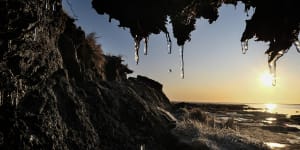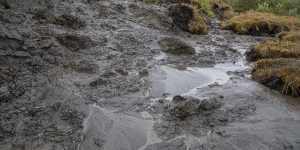When scientists pull drill cores from deep under the surface of the Arctic,they find the ground is,a consequence of our efforts to dig up carbon and pump it into the atmosphere.

Ice melts on tundra and thawing permafrost in Newtok,Alaska.Washington Post/ Bonnie Jo Mount
Some chunks of permafrost have been frozen for hundreds of thousands of years. Trapped inside the ice-crystals are about as many cells as there are stars in the universe.
Some are bacteria. Others are viruses.
As the permafrost thaws,so too do these cells. And scientists are discovering that some ancient species can spring to life – and maybe begin infecting anew.
“Even if this is rare,all it takes is one. And there are so many of them,” said Corey Bradshaw,a professor of global ecology at Flinders University. “This isn’t just sci-fi,this is real.”

A permafrost “thaw slump” on the banks of Esieh Lake in Alaska.Washington Post/ Jonathan Newton
Bradshaw was part of a team that last week trying to quantify the risks from thawing pathogens.
They used computers to simulate the release of ancient pathogens into a modern environment. About 97 per cent of the time,the ancient virus quickly vanished. But about one time in every 100 the released virus found a susceptible host – and mayhem ensued.
“It caused very major damage to the ecosystem – basically the loss of species,” Bradshaw said.
Permafrost generally refers to ground that remains permanently frozen. It’s found under the ice caps, in Canada,Alaska and Russia,and at the tops of the tallest mountains.
About of the land area in the northern hemisphere sits atop permafrost. It’s less common in the southern hemisphere but can still be found in New Zealand and the Antarctic.
The Arctic is warming than the rest of our globe. Parts of the top layer of permafrost have already started thawing. In turn,the water released accelerates the thawing process.
Embedded in this frozen ground are sextillions of cells,Bradshaw said. Most are dead,destroyed by the long freeze.
But some can survive.
Global warming was leading to an "irreversible" mass melting of the Antarctic ice and purging carbon from the atmosphere was the only solution to slow the process,says a UNSW climate scientist.
For certain microbes,“the cold is no problem,” said Andrew McMinn,a professor of Antarctic science at the University of Tasmania.
“As long as you do it properly … we can thaw them out again decades later;there’s no reason why it couldn’t be millenia later.”
Indeed,scientists have bacteria pulled out of a 750,000-year-old ice cap and afrom 30,000-year-old Siberian permafrost. A 2016 anthrax outbreak in Siberia was containing the bacteria.
To thrive,viruses or bacteria need susceptible hosts or the right environment. An ancient virus may struggle to find those,as the animal it evolved to infect is presumably long-dead.
However,should it chance on an animal it can infect,the results can be dramatic – as Bradshaw’s study shows.
Consider the virus that causes COVID-19:it had not infected us before,so we were “immunologically naive” and entirely vulnerable.
While the risk is plausible,other scientists say it is extremely low.
A virus would need to leave permafrost and quickly encounter a susceptible host – unlikely given the remote location and that there are probably few susceptible hosts.
And then it may prove harmless or unable to spread from that host to another.
And there are plenty of other more worrying sources of viruses,such as wild animals. The climate crisis and deforestation are pushing us closer to them,increasing the risk of a virus jumping across –.
“[The likelihood is] not zero,but it’s extremely unlikely,” McMinn said.
Get to the heart of what’s happening with climate change and the environment. Our fortnightly Environment newsletter brings you the news,the issues and the solutions. Sign up.